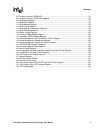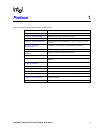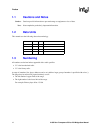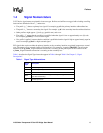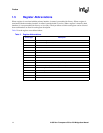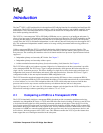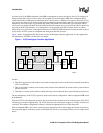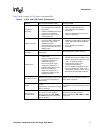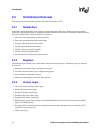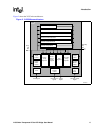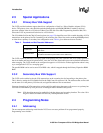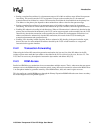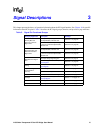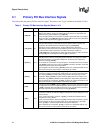
21555 Non-Transparent PCI-to-PCI Bridge User Manual 17
Introduction
Table 3 shows compares a 21555 and to a transparent PPB.
Table 3. 21555 and PPB Feature Comparison
Feature Non-Transparent PPB or 21555 Transparent PPB
Transaction
forwarding
• Adheres to PPB ordering rules.
• Uses posted writes and delayed
transactions.
• Adheres to PPB transaction error
and parity error guidelines,
although some errors may be
reported differently.
• Adheres to PPB ordering rules.
• Uses posted writes and delayed
transactions.
• Adheres to PPB transaction error and
parity error guidelines.
Address decoding
• Base address registers (BARs)
are used to define independent
downstream and upstream
forwarding windows.
• Inverse decoding is only used for
upstream transactions above the
4GB boundary.
• PPB base and limit address registers are
used to define downstream forwarding
windows.
• Inverse decoding for upstream
forwarding.
Address
translation
Supported for both memory and I/O
transactions.
None. Flat address model is assumed.
Configuration
• Downstream devices are not
visible to host.
• Does not require hierarchical
configuration code (Type 0
configuration header).
• Does not respond to Type 1
configuration transactions.
• Supports configuration access
from the secondary bus.
• Implements separate set of
configuration registers for the
secondary interface.
• Downstream devices are visible to host.
• Requires hierarchical configuration code
(Type 1 configuration header).
• Forwards and converts Type 1
configuration transactions.
• Does not support configuration access
from the secondary bus. Same set of
configuration registers is used to control
both primary and secondary interfaces.
Run
-time resources
Includes features such as doorbell
interrupts, I20 message unit, and so
on, that must be managed by the
device driver.
Typically has only configuration registers; no
device driver is required.
Clocks
Generates secondary bus clock
output.
Asynchronous secondary clock input
is also supported.
Generates one or more secondary bus clock
outputs.
Secondary bus
central functions
Implements secondary bus arbiter.
This function can be disabled.
Drives secondary bus AD, C/BE#,
and PAR during reset. This function
can be disabled.
Implements secondary bus arbiter.
Drives secondary bus AD, C/BE#, and PAR
during reset.



